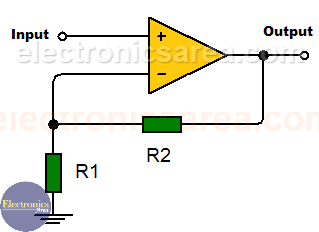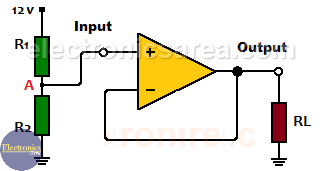Home / Operational Amplifiers / Op Amp Voltage follower / Voltage Buffer
What is an Op Amp Voltage follower?
An Op Amp voltage follower (voltage follower using operational amplifier) is a circuit which has a voltage gain of 1. To better understand the operation of a voltage follower, we must remember the operation of an Op Amp as a non-inverting amplifier. See the diagram below.
Op Amp Non-inverting amplifier
The Op-Amp non-inverting amplifier gain is given by the formula: 1 + (R2/R1).
If we make the R2 resistor value equal to zero and make the R1 resistor value very large, we have an amplifier with gain G = 1. This means that the output signal has the same value as the input signal. See the following diagram.
Op Amp Voltage Follower (Voltage Buffer)
A buffer has an output that is exactly like the input. This feature is very useful for solving impedance matching problems.
- The input impedance of a buffer using an operational amplifier is very high, close to infinity
- The output impedance is very low, just a few ohms.
If the input impedance is very high, it does not load the circuit that is sending the signal, and if its output impedance is low, it can deliver a sufficient amount of current to the circuit receiving the signal.
In other words, a buffer requests very little current from the circuit that gives the signal and greatly increases the capacity to deliver current to the circuit that receives the signal.
Voltage follower advantages
- Provides power gain and current gain. (voltage gain = 1).
- Low output impedance. Loading effects can be avoided.
- High input impedance. The op-amp takes no current from the input.
Voltage follower applications
- Sample and hold circuits.
- Buffers for logic circuits.
- Active filters. Voltage followers can be used to isolate filter stages from each other, when building multistage filters.
Op Amp voltage follower example
We need to get 6 volts from a 12 volt source to power a 100 ohm load resistor (RL).
We use two 100K resistors in series as a voltage divider (R1, R2). Since the resistors have the same value, the voltage between them is exactly 6 volts (A).
If we connect the 100 ohm load to point A, the voltage will no longer be 6 volts, because the lower 100K resistor is in parallel with the load. The equivalent resistance of parallel resistors is: 100,000 x 100 / (100,000 + 100) = 99.9 ohms. We can safely assume the approximate value of 100 ohms.
Using the voltage divider again, the voltage at point A is: VA = 12 / (100K + 100) x 100 = 0.012 volts. Very different from the expected 6 volts.
To avoid this problem, we use an op amp voltage follower. The non-inverting input of the op amp is connected to A and the output is connected to the 100 ohm resistor (load). The load will have exactly 6 volts between its terminals.







